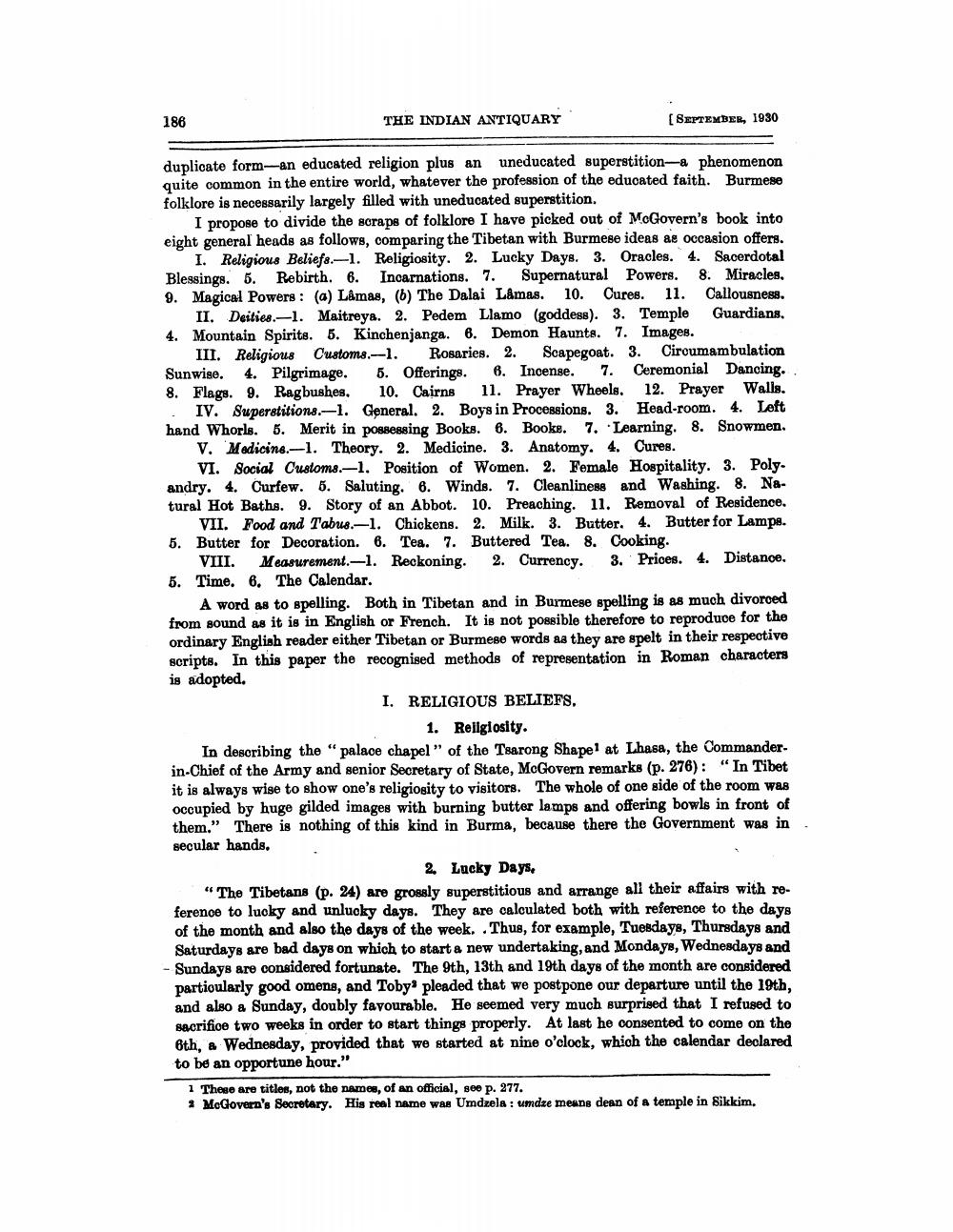________________
186
THE INDIAN ANTIQUARY
[ SEPTEMBER, 1930
duplicate forman educated religion plus an uneducated superstition-a phenomenon quite common in the entire world, whatever the profession of the educated faith. Burmese folklore is necessarily largely filled with uneducated superstition
I propose to divide the scraps of folklore I have picked out of MoGovern's book into eight general heads as follows, comparing the Tibetan with Burmese ideas as occasion offers.
I. Religious Beliefs.-1. Religiosity. 2. Lucky Days. 3. Oracles. 4. Sacerdotal Blessings. 5. Rebirth. 6. Incarnations. 7. Supernatural Powers. 8. Miracles, 9. Magical Powers: (a) Låmas, (b) The Dalai Lamas. 10. Cures. 11. Callousness.
II. Deities.-1. Maitreya. 2. Pedem Llamo (goddess). 3. Temple Guardians 4. Mountain Spirits. 5. Kinchenjanga. 6. Demon Haunte. 7. Images
III. Religious Customs.--1. Rosaries. 2. Scapegoat. 3. Circumambulation Sunwise. 4. Pilgrimage. 5. Offerings. 6. Incense. 7. Ceremonial Dancing. 8. Flags. 9. Ragbushes. 10. Cairns 11. Prayer Wheels 12. Prayer Walls.
IV. Superstitions.--1. General. 2. Boys in Processions. 3. Head-room. 4. Left hand Whorls. 5. Merit in possessing Books. 6. Books. 7. Learning. 8. Snowmen,
V. Medicine.-1. Theory. 2. Medicine. 3. Anatomy. 4. Cures.
VI. Social Customs.-1. Position of Women. 2. Female Hospitality. 3. Polyandry. 4. Curfew. 5. Saluting. 6. Winds. 7. Cleanliness and Washing. 8. Natural Hot Baths. 9. Story of an Abbot. 10. Preaching. 11. Removal of Residence.
VII. Food and Tabus.--1. Chickens. 2. Milk. 3. Butter. 4. Butter for Lamps. 5. Butter for Decoration. 6. Tea. 7. Buttered Tea. 8. Cooking.
VIII. Measurement.-1. Reckoning. 2. Currency. 3. Prices. 4. Distance. 5. Time. 6. The Calendar.
A word as to spelling. Both in Tibetan and in Burmese spelling is as much divorced from sound as it is in English or French. It is not possible therefore to reproduce for the ordinary English reader either Tibetan or Burmese words as they are spelt in their respective scripts. In this paper the recognised methods of representation in Roman characters is adopted.
I. RELIGIOUS BELIEFS.
1. Religiosity. In describing the “palace chapel" of the Tsarong Shapel at Lhasa, the Commanderin-Chief of the Army and senior Secretary of State, McGovern remarks (p. 276): "In Tibet it is always wise to show one's religiosity to visitors. The whole of one side of the room was Occupied by huge gilded images with burning butter lamps and offering bowls in front of them." There is nothing of this kind in Burma, because there the Government was in secular hands.
2 Lacky Days "The Tibetans (p. 24) are grossly superstitious and arrange all their affairs with reference to luoky and unlucky days. They are calculated both with reference to the days of the month and also the days of the week. Thus, for example, Tuesdays, Thursdays and Saturdays are bad days on which to start a new undertaking, and Monday, Wednesdays and Sundays are considered fortunate. The 9th, 13th and 19th days of the month are considered partioularly good omens, and Toby pleaded that we postpone our departure until the 19th, and also a Sunday, doubly favourable. He seemed very much surprised that I refused to sacrifice two weeks in order to start things properly. At last he consented to come on the 6th, & Wednesday, provided that we started at nine o'clock, which the calendar declared to be an opportune hour."
.
1 These are titles, not the names, of an official, see p. 277.
MoGlovern's Secretary. His real name was Umdzela : umdae means dean of a temple in Sikkim,




